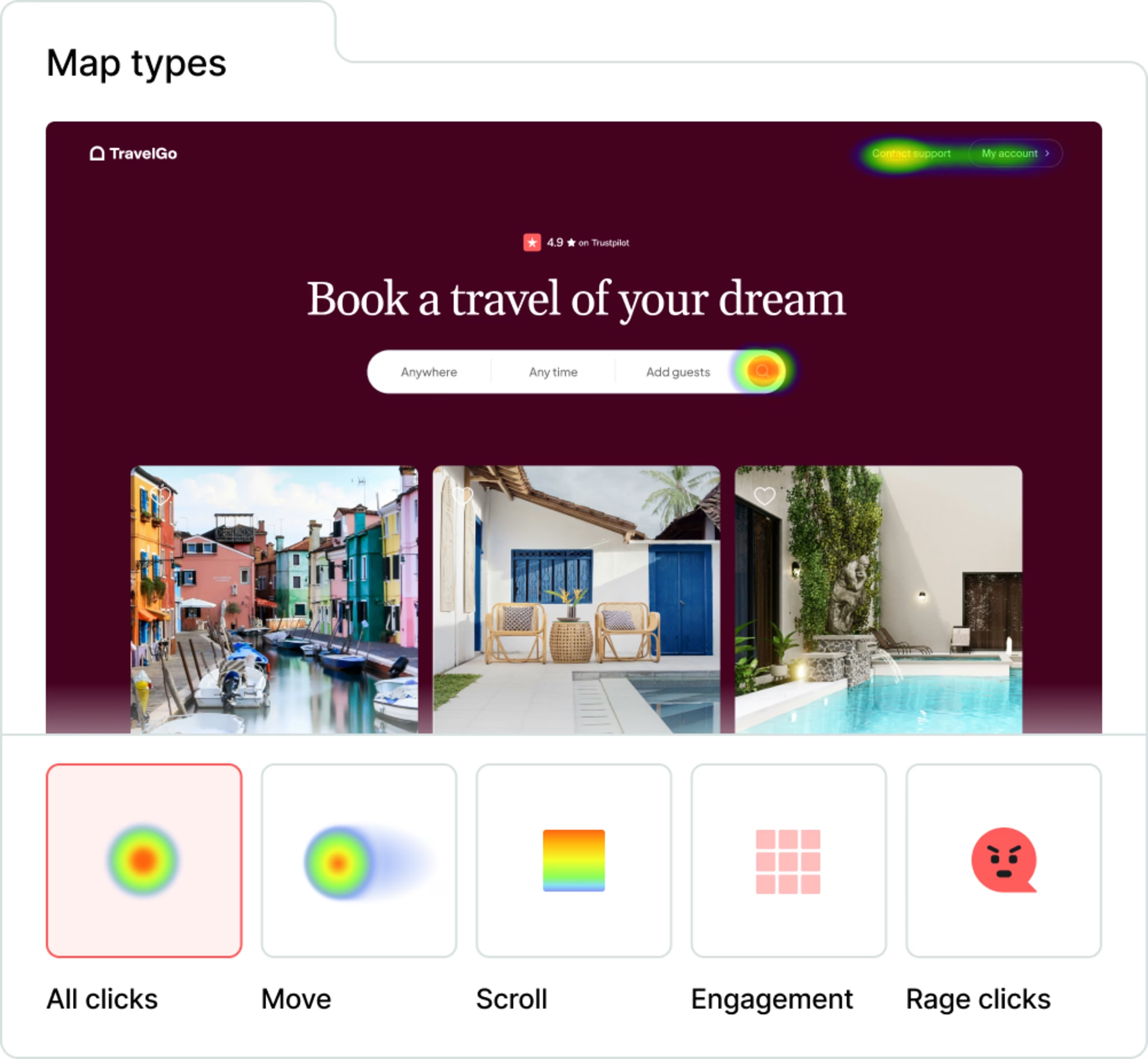Keeping customers happy isn’t just good for business—it’s survival. Your growth depends on how well you understand and adapt to their needs. And that starts with a rock-solid customer feedback strategy—one that helps you elevate your customer relationships and digital experience.
This is the ultimate guide to creating a powerful customer feedback strategy: learn how to collect, share, and analyze feedback and get actionable ideas on what to do with your new insights for business and customer success.
6 steps to build a customer feedback framework that works
A solid customer feedback strategy involves creating a customer feedback loop: a cycle of continuously asking for feedback and implementing changes and improvements. This lets you develop your product while getting feedback on whether customers react positively to the changes you make.
Customer feedback is the most crucial component of any organization or business. It can take various forms, including product feedback, customer service feedback, customer happiness feedback, and, most importantly, complaints, which help you identify areas for development. A customer feedback strategy, on the other hand, is the creation of a master plan to execute the feedback you get from individuals who use your product. Without this master plan, you will have no idea where to start, how to start, or when to start.
Use the steps below as a replicable framework to help build your own customer feedback strategy and create a sustainable feedback loop—so you can consistently meet customer needs and improve satisfaction.
1. Define feedback goals
Firstly, you’ll need to set goals to form the basis of your customer feedback strategy—for example, finding out what customers think of your support service or your website design changes.
Having a strategy for creating a feedback loop is important since it’s a process that is nearly always in motion. Goals should be part of this strategy, because they’ll help you track and measure progress, without having to break the loop.
Once you’ve determined your goals, design a feedback campaign by choosing research methods and customer feedback software that give you the most relevant insights and answers. Here’s how:
Develop your ideal customer profile (ICP) to understand your customers and create user personas to help segment your best customer type(s) based on key demographics, pain points, and purchasing behaviors
Segment your customers with tools like Contentsquare’s User Segmentation to better understand your product and goals for each customer segment—and guide your questions and feedback strategy
Pick the right tools based on your customer feedback goals. Let’s say your SaaS startup wants to measure the success of its product page within a specific customer segment. Use digital experience insights tools like Contentsquare’s feedback widgets for real customer responses, or watch recordings of user sessions for deeper insights into the customer experience.
![[Visual] Feedback button - How would you rate your experience](http://images.ctfassets.net/gwbpo1m641r7/6zpie5F6Gwd4oyqXaxBfcN/b7e9b7f3bfcc6265f47b5294d8fec319/Feedback_button.png?w=3840&q=100&fit=fill&fm=avif)
Contentsquare’s feedback widget makes it easy to collect feedback and create a continuous feedback loop
2. Collect feedback
How you gather feedback largely depends on your customers’ motivators, blockers, and needs—and which feedback collection methods most resonate with them.
For example, if your ecommerce business notices customers don’t offer feedback through post-purchase email surveys, you’d want to change how and where you ask for feedback. In this instance, placing a feedback widget on a post-checkout success page could deliver immediate insights into their shopping experience.
When asking for feedback, consider your target audience's most relevant channels and be specific about what you want to know.
Use sentiment analysis tools like Brandwatch to spot any mentions of your product or brand across social media channels for unsolicited, emotionally-driven customer feedback
Check out popular review websites, like Capterra, Trustpilot, TrustRadius, and G2, for product reviews and competitor analysis. These sites also offer insights into product-market fit, market gaps, and potential product features.
Use unobtrusive feedback widgets for quick temperature checks on customer experiences and frustrations. Place them on key conversion pages—like landing, checkout, home, and product pages—to see what delights customers or blocks them along their journey.
Place timed surveys throughout the customer journey. Use customer satisfaction (CSAT) surveys for feedback on short-term customer satisfaction and exit-intent surveys to understand why customers decide to leave a page.
A/B test website features or new page designs, and get customer feedback on specific variants to help elevate and personalize the customer experience. For example, let’s say your user experience (UX) team wants to test call-to-action (CTA) button placement and colors on various customer types. They could A/B test a variety of buttons and measure their success on different segments to better engage and retain customers.
💡Pro tip: supercharge your A/B tests with Contentsquare's Session Replay capability—watch real user sessions unfold across test variants to see exactly what influences decisions, spot friction points, and refine your optimizations with confidence.
![[Visual] AB Testing and session replay](http://images.ctfassets.net/gwbpo1m641r7/3pyi6K866dXK51H98XtJnd/fa1e174cb7560d0cd9e565aca3fb9019/Experience_Analytics_-_AB_Test__1_.png?w=3840&q=100&fit=fill&fm=avif)
See exactly how users interact with your A/B test variants with Contentsquare’s Session Replay capability
3. Analyze customer feedback
To prioritize and act on customer feedback, you first need to analyze and interpret it, looking for patterns in product usage, customer satisfaction, and immediate fixes or bugs.
Sort your feedback based on feedback type and volume to better analyze and spot any issues that need to be addressed quickly.
So, how do you analyze customer feedback to glean crucial customer insights?
Gather group feedback based on demographics and quantitative data, like CSAT and NPS® scores, and qualitative feedback, like surveys, feedback forms, and focus groups, for deeper insights into customer behavior across segments
Use AI tools like Contentsquare AI to analyze and categorize your feedback and create reports that quickly summarize response themes and emotions
Visualize customer feedback with dynamic dashboards that show live charts of customer sentiment scores and incoming feedback. For example, after spotting a low customer sentiment score, your product design team might look into specific market trends or patterns in customer behavior for detailed insights. Then, they can make consumer-backed product improvements.
![[Screenshot] CSQ customizable dashboard](http://images.ctfassets.net/gwbpo1m641r7/4K5kPPA3D3wt2jenJJbUlq/0f7dfb8f30f106db798a5b74740a9d04/Screenshot_2025-02-24_001510.png?w=3840&q=100&fit=fill&fm=avif)
Contentsquare’s customizable dashboards help you visualize customer feedback and overall customer sentiment
4. Share customer feedback
You need to share customer feedback across teams to act fast and resolve any customer concerns or problems.
Not only does sharing feedback across the board help unify disparate teams around a common goal, it also gives you insights from both customer-facing and non-customer-facing teams for more unified decision-making.
Here’s how to easily share customer feedback across teams:
Use intuitive dashboards that help your teams visualize key customer feedback and insights—and easily spot areas of improvement across departments
Highlight important feedback and activity. If you’re using Contentsquare’s Session Replay capability, deploy the Snapshot feature to extract key customer insights and feedback. Then, share your highlighted snippets across teams and create collections of related insights. This gives teams easy access to crucial customer actions, such as rage clicks.
![[Visual] Session replay snapshot](http://images.ctfassets.net/gwbpo1m641r7/IXFMTMNyJUeEZiuIkWIUY/3150b895ddd91517ab0036bea174289e/Screenshot_2025-02-01_011249.png?w=3840&q=100&fit=fill&fm=avif)
Contentsquare’s Snapshot feature lets you capture the exact moments you’re wanting to share across teams.
Use workplace messaging apps to unite your teams and quickly share important customer feedback. For example, with Contentsquare’s Slack integration, you can get incoming feedback and survey responses about site issues, like a sign-in bug. Your product team can then jump in to resolve the problem before it negatively impacts the customer experience.
![[Visual] forward](http://images.ctfassets.net/gwbpo1m641r7/2Z3Y9NlvtPAVCudN7aKopX/4661c0c39626406e04cb0d63b79f8c22/forward.png?w=3840&q=100&fit=fill&fm=avif)
Contentsquare’s Slack integration gives your teams instant access to customer feedback
5. Act on your insights
Once you’ve sorted customer feedback based on volume and type and shared it across teams, you’ll need to decide what needs immediate attention and improvement. And, what to add to your product backlog for future development.
Prioritize customer requests that directly impact their experience to make sure they can quickly see the value of your product.
How to act on your insights to ensure customer delight:
Fix any urgent issues or bugs that negatively impact the customer experience and don’t take much to implement. For example, after receiving feedback about a broken checkout link, your ecommerce team would need to act quickly to fix the link so it doesn’t negatively affect customer retention.
Prioritize your product roadmap around updates or features that help your customers achieve their goals and complete their tasks—and better highlight your unique selling point (USP)
Manage your product backlog by reviewing and prioritizing tasks regularly. Make sure you delete tasks that aren’t necessary and update your processes to reflect your current product and customer goals.
💡Pro tip: use Contentsquare’s Heatmaps capability to spot urgent product changes and bugs. See user activity on your website or product to identify rage clicks, confusion, or glitches in the user experience that need to be fixed.

Contentsquare’s Heatmaps shows you every click, hover, scroll, or tap your user makes.
6. Follow up with customers
To empathize with your customers and identify improvements, you need to ask them about their experience with your brand and product post-purchase.
When you follow up with your customers, you get valuable insights into product adoption, usability, and success, as well as the ability to make customer-backed product decisions.
So, how do you follow up and engage with your customers post-purchase?
Ask for feedback. Have customers rate their experience and provide a reason for their score. If you’re using Contentsquare’s Voice-of-Customer (VoC) product, you can add feedback buttons across your site, inviting customers to tell you what they like or dislike, giving you actionable insights to improve their experience.
Use surveys to gauge customer satisfaction with your product. Use B2B usability surveys to understand B2B product adoption and usability, Use NPS® surveys for feedback on long-term customer satisfaction and referral rates and post-purchase surveys to understand how your users felt about your checkout page.
Contentsquare’s post-purchase surveys let you follow up with customers about their checkout experience
Level up your customer feedback strategy with digital experience insights
Your customer feedback strategy should revolve around making sure your feedback loop has no barriers. And should enable you to consistently use feedback to update your product and customer experience.
With the steps listed above, you’ll be ready to bolster your customer feedback strategy and spot any gaps in your process. This not only shows your customers you’re listening to them but also leads to a streamlined customer experience. And, when you combine customer-backed insights with digital experience insights, you can determine exactly what’s driving their feedback—so you know what to improve and why.
![[Visual] Churn prevention - stock image](http://images.ctfassets.net/gwbpo1m641r7/1pt2xn0ppryr3YCMcnF22C/58b89c56360789c3df903a756975a35c/AdobeStock_520992702.png?w=3840&q=100&fit=fill&fm=avif)
